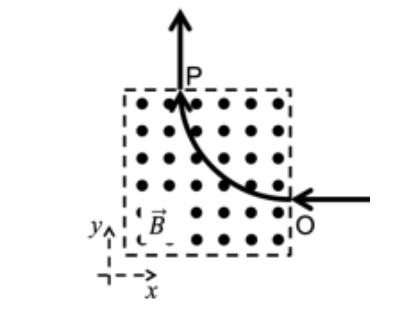The figure below shows a charged particle that enters at point O and exits at point P. In the given system, the velocity of the particle is perpendicular to the uniform magnetic field B. The mass of the particle is 1.50 × 10^−26[kg], the uniform magnetic field in the system is +50.0[T]k, the speed of the particle is 1.20 × 10^5[m/s], and the time of flight of the particle from point O to point P is 7.50 × 10^−8[s]. What is the charge (magnitude and sign) of the particle? What is the radius of the curved path that is traced by the particle?
The figure below shows a charged particle that enters at point O and exits at point P. In the given system, the velocity of the particle is perpendicular to the uniform magnetic field B. The mass of the particle is 1.50 × 10^−26[kg], the uniform magnetic field in the system is +50.0[T]k, the speed of the particle is 1.20 × 10^5[m/s], and the time of flight of the particle from point O to point P is 7.50 × 10^−8[s]. What is the charge (magnitude and sign) of the particle? What is the radius of the curved path that is traced by the particle?
An Introduction to Physical Science
14th Edition
ISBN:9781305079137
Author:James Shipman, Jerry D. Wilson, Charles A. Higgins, Omar Torres
Publisher:James Shipman, Jerry D. Wilson, Charles A. Higgins, Omar Torres
Chapter15: Place And Time
Section15.3: Time
Problem 1PQ
Related questions
Question
The figure below shows a charged particle that enters at point O and exits at point P. In the given system, the velocity of the particle is perpendicular to the uniform magnetic field B. The mass of the particle is 1.50 × 10^−26[kg], the uniform magnetic field in the system is +50.0[T]k, the speed of the particle is 1.20 × 10^5[m/s], and the time of flight of the particle from point O to point P is 7.50 × 10^−8[s].
- What is the charge (magnitude and sign) of the particle?
- What is the radius of the curved path that is traced by the particle?

Transcribed Image Text:X
P
Expert Solution
This question has been solved!
Explore an expertly crafted, step-by-step solution for a thorough understanding of key concepts.
Step by step
Solved in 4 steps

Knowledge Booster
Learn more about
Need a deep-dive on the concept behind this application? Look no further. Learn more about this topic, physics and related others by exploring similar questions and additional content below.Recommended textbooks for you

An Introduction to Physical Science
Physics
ISBN:
9781305079137
Author:
James Shipman, Jerry D. Wilson, Charles A. Higgins, Omar Torres
Publisher:
Cengage Learning

An Introduction to Physical Science
Physics
ISBN:
9781305079137
Author:
James Shipman, Jerry D. Wilson, Charles A. Higgins, Omar Torres
Publisher:
Cengage Learning